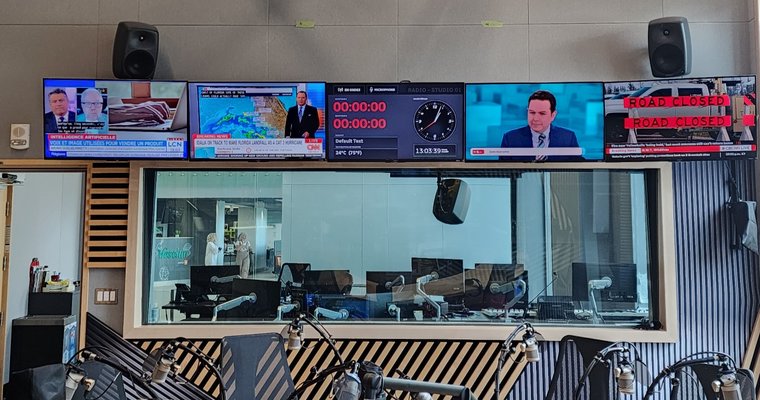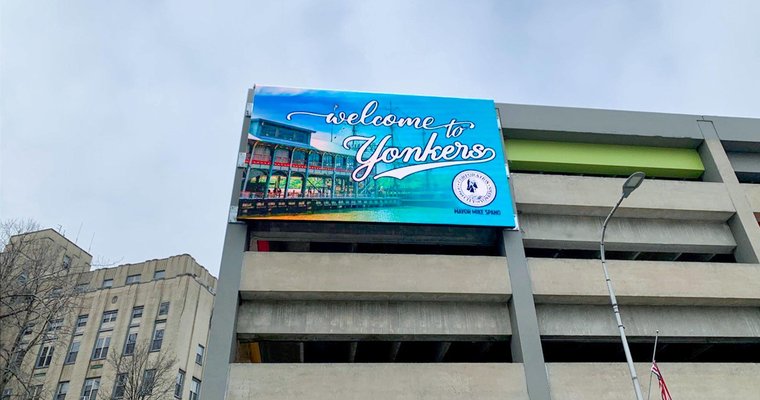
[ad_1]
Sanjeev Kharbanda, Director, Media Core Systems at the Canadian Broadcasting Corporation, met with Daniel Brown, Editor of Digital Signage Today, via video link from Toronto, Canada to discuss CBC’s modernizing of studios.
 A CBC studio shot featuring innovative software, digital signage, and control solutions. Image provided by CBC.
A CBC studio shot featuring innovative software, digital signage, and control solutions. Image provided by CBC.
Sanjeev Kharbanda, Director, Media Core Systems at the Canadian Broadcasting Corporation, met with Daniel Brown, Editor of Digital Signage Today, via video link from Toronto, Canada. Kharbanda has 35 years of broadcast technology experience and has helped modernize various control systems at CBC studios, in part thanks to some of the hardware and software on display in London at BBC headquarters during a CBC staff visit.
“I am responsible for all the core systems which are centralized to multiple facilities,” Kharbanda said. “We just went through a major upgrade in our Montreal building,” he added, explaining that the traditional radio and TV headquarters for CBC was the Maison Radio-Canada, or MRC. “They built a building next to the old building in the parking lot, and they called it ‘New MRC,’ New Maison Radio-Canada.”
CBC OVERVIEW
For those unfamiliar with Canadian broadcasting, Kharbanda pointed to the BBC in the United Kingdom as a similar example familiar to international audiences.
“CBC Radio Canada is Canada’s national public broadcaster,” Kharbanda said. “Our mandate is to celebrate Canadian culture and support democratic life through a wide range of content that informs, enlightens, and entertains. CBC Radio Canada plays a central role in Canadian culture, and offers a uniquely Canadian perspective on news, current affairs, and world affairs.
“It provides content in Canada’s two official languages, which are English and French, as well as in eight indigenous languages. CBC Radio Canada began radio broadcasts in 1936,” Kharbanda added. “Today it is a multiplatform public service media company — so we are on radio, television, the web, YouTube, we are everywhere now.
“Our corporate head office is in Ottawa, and we have two major media headquarters. One is the English headquarters based in Toronto, and the French services headquarters is in Montreal. The English service is called CBC, and the French service is called Radio Canada.
“We have community-based locations across the country, including 27 television stations, 88 radio stations… and one digital news station. CBC Radio Canada has five subscription television channels and four Canada-wide radio networks — two in English and two in French. Around the world it has five permanent foreign bureaus and sets up temporary bureaus as needed — so we have some presence across the international stage also.”
Modernizing the hardware and software in studios
The hectic demands of daily broadcasting across platforms, particularly in the old MRC building, brought opportunities for innovation. “These workflows are not new workflows, so we were able to meet most of the requirements,” Kharbanda said. Similar to IT and pro AV environments in other industries, the aging system was something of a Ship of Theseus, with a growing set of purpose-built, obsolescent solutions requiring difficult maintenance and forcing production teams and on-air talent to look at multiple screens for basic information, such as countdown timers for recording, mic, camera and broadcast notifications, along with unique status notifications for various recording and broadcasting triggers.
“When we were looking for a system for the NMRC, what we wanted to do was actually consolidate all these workflows into one system and make sure that we are able to provide this functionality to users and do not increase our support cost and maintenance cost too much,” Kharbanda said. “We decided to go with one system, and that’s where IDS came into play. We are using it for production timers in the studio, we are using it on-air status, like when a microphone turns on and off. We are using it to display IPTV signal, that was the target but I think we are still working on it a bit. And a clock – so now we are showing the clocks on the signal. Before, as you can imagine, there were a lot of mechanical clocks spread out around the building, and now the clocks are integrated in the same screen.
“IDS really helped us to consolidate all of these different, diverse workflows into one system, and when we brought it in and started playing with it, we found out that it can do additional stuff,” Kharbanda said. With multiple studios in use, some broadcasting live content and others recording pre-packaged content for later broadcast, IDS made things easier by integrating with the other studio systems, including Raspberry ITX and VSM, so as to provide countdown timers to count you in and out for on-the-air broadcasting status, in addition to other status indicators like the active mic status. For those unfamiliar, “VSM is a LAWO product,” Kharbanda said. “Virtual Studio Manager, it’s what we call a broadcast controller.”
IDS has two main components, Kharbanda said, including a display component for sharing information (which can be broadcast to simple, non-touch displays anywhere in the studio), and control panels, which can integrate with touchscreens, like for when a host plays a video clip. “When you’re playing a clip, the on-air host can relax, because a clip is going to play for two and a half or three minutes,” Kharbanda said. “So what they typically do is start a timer to countdown: they touch the screen, enter the time for however long the clip is, and start counting down.” This allows hosts to know exactly how long they have before they are back on air and need to start talking again.
Thanks to DMX lighting control automation, it’s now easy to switch between lighting presets for morning and afternoon shows. But then, with the versatility of the software, the team is still exploring new automations to simplify workflows.
“We don’t like to call it automation, because automation is a word which can be used in a different context. We call it ‘assisted automation,'” Kharbanda said. “It assists you to do your work more efficiently. And also, if there’s some very repetitive task which does not need much human value, then we can automate our systems so that they can assist you with doing your broadcast job better, so then you’re more focused.”
Similar to users in other industries, from food to retail, Kharbanda feels that the place of automation in his workplace is not replacing humans, but freeing them up for more creative work and problem solving instead of focusing on boring repetition.
REPORTS OF BROADCASTING’S DEMISE HAVE BEEN GREATLY EXAGGERATED
When asked about the periodic “death of an industry” articles that appear in media about TV and radio, Kharbanda is skeptical.
“I think every industry goes through change,” he said. “I don’t think it’s dead, I think change is coming,” including the proliferation and variety of personal devices that have combined audio and video in new ways. People want video now with their traditionally audio-only content, including various live radio staples.
Thanks to the streaming revolution spurred by Netflix and others, Kharbanda says on-demand is another major shift.
“In their free time, people want to listen to whatever they want,” Kharbanda said, so instead of being forced to absorb a playlist created by someone else (the traditional over-the-air model), consumers now want the option of curated playlists or choosing their content on demand. Radio is adapting to the podcast model, he added, and there are experiments with web-based content, including added video, what the team calls “visual radio,” similar to video podcasts, though there is less video production involved, with selective filming based on which mic is active and other criteria.
“Our industry has to go through change, because at the end of the day, the audience is king,” he concluded, noting that radio is still strong. “Radio is still an important media for us. People still listen to it. It’s very live — that’s the nature of radio, it’s very live. You still count on it to provide the last-minute story. But we also have to adapt to audience preferences,” he said. “You want to make sure that your content is tuned to your audience.”
 |
Close-up of studio timer solution with touchscreen features. Image provided by CBC. |
Editor’s note: Kharbanda confirmed that CBC’s English language content included launching the Schitt’s Creek franchise that has become a global sensation and which he said remains one of CBC’s most popular programs.
RELATED:
A voice crying out in wilderness, ‘What about content?’ | Digital Signage Today
Daniel Brown is the editor of Digital Signage Today, a contributing editor for Automation & Self-Service, and an accomplished writer and multimedia content producer with extensive experience covering technology and business. His work has appeared in a range of business and technology publications, including interviews with eminent business leaders, inventors and technologists. He has written extensively on AI and the integration of technology and business strategy with empathy and the human touch. Brown is the author of two novels and a podcaster. His previous experience includes IT work at an Ivy League research institution, education and business consulting, and retail sales and management.
[ad_2]
Source link






